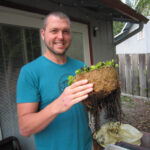Are tiny bugs buzzing around your kitchen? You might have fruit flies, or possibly gnats! Don’t worry. These common household pests are annoying, but getting rid of them is easier than you think. You probably already have everything you need right in your kitchen to make effective traps.
Recently, we had a fruit fly situation at home – our first in years! This gave me the perfect chance to put various fruit fly elimination methods to the test. Yes, notes were taken, and even a spreadsheet was involved. Today, I’m sharing the best homemade fruit fly traps and step-by-step instructions on how to make them.
These DIY traps are simple to create using natural ingredients you likely have on hand. They’re budget-friendly, chemical-free, and incredibly easy to make. If you’re feeling kind, you can even release the captured fruit flies outside rather than, well, the alternative. Humane fruit fly trap options are definitely on the table here. We’ll also cover how to prevent fruit fly infestations in the first place, so you can avoid this nuisance altogether.
What Exactly Are Fruit Flies?
Fruit flies are small, winged insects that are drawn to ripe or fermenting fruits and vegetables, just as their name suggests. They’re also attracted to sugary spills, fermented drinks like beer and wine, and even garbage. You’ll often see them congregating around fruit bowls, trash cans, and sometimes even kitchen drains. They are tiny, about the size of a grain of rice, and look like small, tan or brownish houseflies, often with distinctive red eyes. Fruit flies are most prevalent during the summer and fall when fruits are in season.
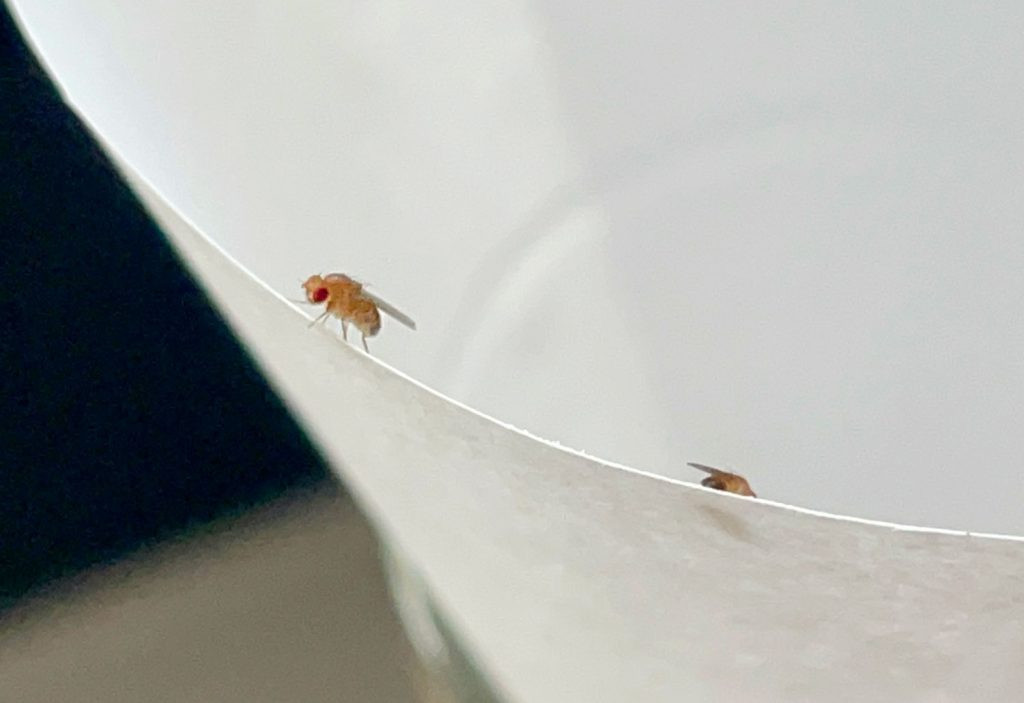 Close Up Of Fruit Fly On Paper Funnel
Close Up Of Fruit Fly On Paper Funnel
A fruit fly infestation can start with just a few bugs hitching a ride into your home on groceries. However, female fruit flies can lay hundreds of eggs in their short lifespan, and these eggs can hatch in as little as 12 hours. They mature into adults within days, meaning a small initial problem can quickly escalate into a large swarm. That’s why it’s crucial to act fast to get rid of fruit flies as soon as you notice them.
Fruit Flies, Fungus Gnats, and Drain Flies: Know the Difference
Fruit flies are often confused with other small flying insects in the house, especially fungus gnats and drain flies. All are small and annoying, but identifying them correctly is key to choosing the most effective elimination method. The easiest way to tell them apart is by where you see them and what they look like compared to larger insects.
- Fruit Flies: Resemble tiny flies. Found near fruit bowls, garbage, spilled food, and other fermenting or sugary sources.
- Drain Flies: Look like small, fuzzy moths. Usually seen around sinks, drains, and damp areas.
- Fungus Gnats: Look like small mosquitoes. Typically found near houseplants, as they breed in moist potting soil.
If you’re unsure which pest you’re dealing with, try one of the traps described below. If it attracts the bugs in your home, you likely have fruit flies!
4 Simple DIY Fruit Fly Trap Recipes
Eliminating fruit flies doesn’t have to be complicated or expensive. You probably have everything you need already. The basic principle of each trap is the same: attract the fruit flies and then prevent them from escaping. We tested these 4 DIY methods and found a clear winner. Since each method uses common household items, it’s worth trying more than one to see what works best for you. Consider yourself a fruit fly scientist for a bit! Here are the first 4 methods we experimented with:
- Funnel Trap
- Plastic Wrap Trap
- Dish Soap Trap
- Rotting Fruit Trap
Let’s dive into the details of each method, and I’ll share our verdict on the most effective one later on. Keep in mind that some traps work faster than others, and it might take a few days to fully resolve your fruit fly problem.
#1: The Paper Funnel Fruit Fly Trap
This trap uses a paper funnel to guide fruit flies into a container. The narrow opening at the bottom of the funnel makes it easy for flies to enter but difficult to exit.
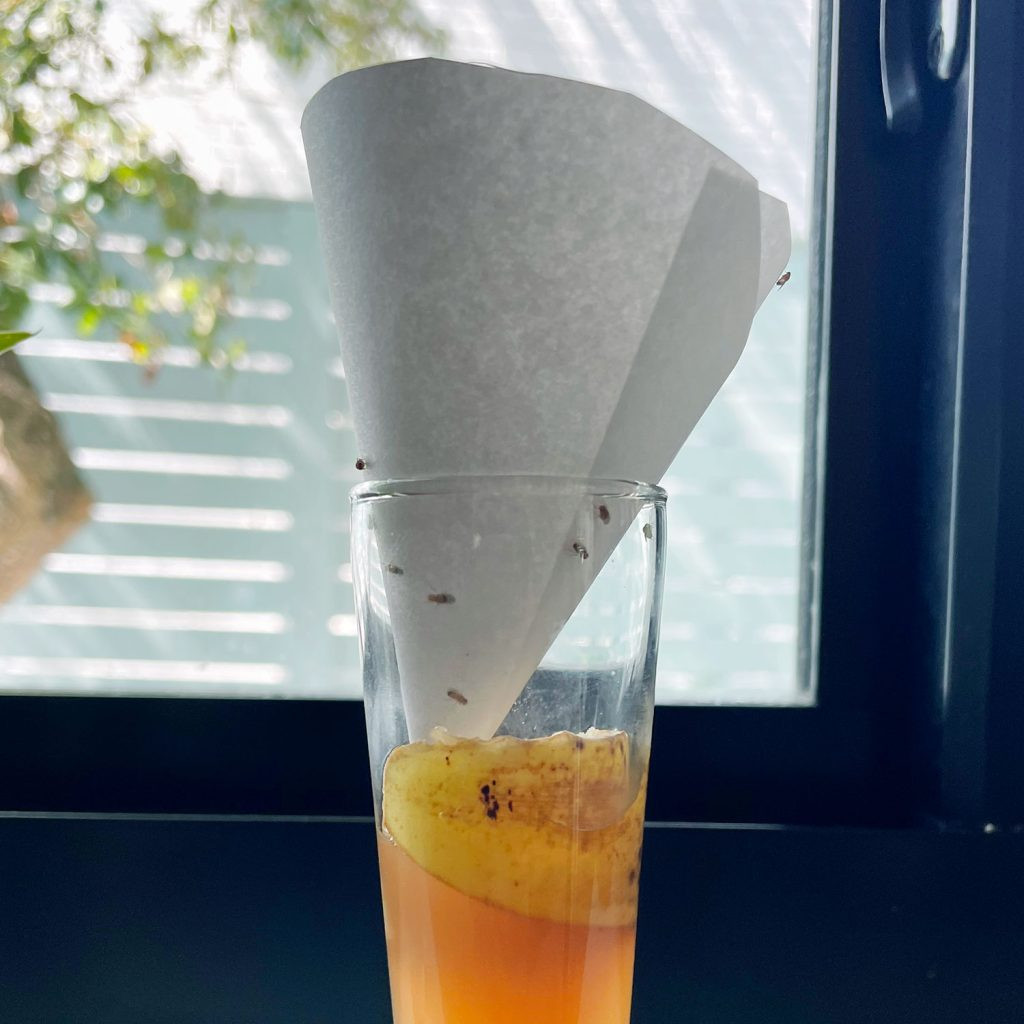 DIY Fruit Fly Trap With Paper Funnel
DIY Fruit Fly Trap With Paper Funnel
Supplies:
- Small clear jar, cup, or container (narrow opening preferred)
- Piece of paper or cardstock
- Tape
- Scissors
- Apple cider vinegar (ACV)
Instructions:
- Choose Your Container: Select a small, clear container like a clean food jar or plastic bottle. A narrow opening is beneficial for this trap.
- Add Apple Cider Vinegar: Pour a small amount of apple cider vinegar, old beer, or wine into the bottom of the container. These liquids are excellent fruit fly attractants.
- Make the Funnel: Roll a piece of paper or cardstock into a cone shape with a very small opening at the tip. Secure the cone shape with tape. Trim the tip to create a small hole, roughly the size of a grain of rice.
- Set Up the Funnel: Place the paper funnel into the container opening. Adjust the funnel so it sits securely on the rim without touching the liquid. Ensure there are no gaps around the funnel’s edge where flies could escape.
- Optional Humane Release: To release captured flies, carefully take the trap outside, keeping the funnel in place. Remove the funnel outdoors to allow the flies to fly away.
While you could use a store-bought funnel, the opening is often too wide, allowing captured fruit flies to escape. A homemade paper funnel with a small opening is more effective.
#2: The Plastic Wrap Fruit Fly Trap
Similar to the funnel trap, this method uses the scent of apple cider vinegar to attract fruit flies. They enter through tiny holes in the plastic wrap covering the container but struggle to find their way back out.
Supplies:
- Small clear jar, cup, or container
- Rubber band
- Plastic wrap or a plastic bag
- Toothpick
- Apple cider vinegar (ACV)
Instructions:
- Choose Your Container: Select a small, clear jar, cup, or similar container. Clarity helps you monitor your trap’s success, but any container will work.
- Add Apple Cider Vinegar: Pour apple cider vinegar into the container. Its sweet, fermented scent is irresistible to fruit flies. Old beer or wine also works, but avoid white vinegar, as it’s not as attractive to them.
- Cover with Plastic Wrap: Stretch plastic wrap tightly over the container opening and secure it with a rubber band. Saran wrap is ideal, but you can also use a piece cut from a plastic bag.
- Poke Small Holes: Use a toothpick to poke several small holes in the plastic wrap top. The holes should be large enough for a fruit fly to enter but small enough to discourage escape.
- Optional Humane Release: To release the flies, carefully carry the trap outside without removing the plastic wrap. Once outside, remove the plastic wrap to let the flies escape.
Alternatively, you can use a metal jar lid. Puncture a small hole in the lid using a hammer and nail, then screw the lid onto the jar.
#3: The Dish Soap Fruit Fly Trap
This trap is different as it doesn’t require a cover. Instead, it uses dish soap to break the surface tension of the liquid, trapping the fruit flies. Note: Flies trapped in this method won’t be able to be released.
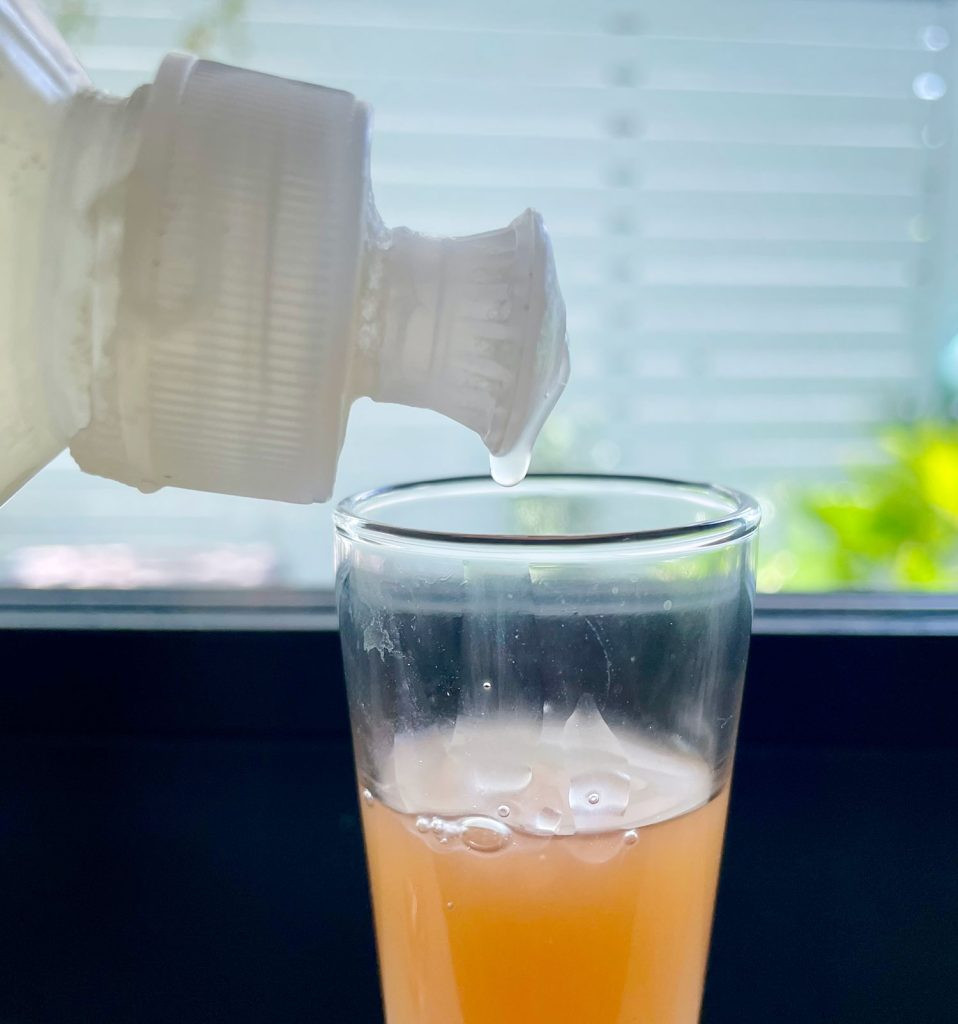 Dripping Dish Soap Into Apple Cider Vinegar For DIY Fruit Fly Trap
Dripping Dish Soap Into Apple Cider Vinegar For DIY Fruit Fly Trap
Supplies:
- Small container, bowl, or dish
- Dish soap
- Apple cider vinegar (ACV)
Instructions:
- Pour Apple Cider Vinegar: Fill the bottom of a small container, bowl, or dish with apple cider vinegar. The scent will attract the fruit flies.
- Add Dish Soap: Add a few drops of dish soap to the apple cider vinegar and gently mix. The soap reduces the surface tension, causing flies to sink when they land on the liquid.
This method can also be combined with the plastic wrap or funnel traps. Adding dish soap to the apple cider vinegar before covering the container provides an extra way to trap the flies.
#4: The Rotting Fruit Fruit Fly Trap
Fruit flies are drawn to rotting fruit, so using actual fruit as bait can be incredibly effective.
Supplies:
- Small glass jar, cup, or container
- Plastic wrap or paper funnel (depending on your chosen trap style)
- Small piece of fruit, such as banana peel or apple slice
Instructions:
To make a rotting fruit trap, simply replace the apple cider vinegar in either the Plastic Wrap or Funnel trap with a piece of ripe or overripe fruit like a banana peel, apple slice, or peach. You can also add fruit to your apple cider vinegar for extra attraction. Be sure to replace the fruit every day or two to prevent unpleasant odors in your kitchen.
Finding the Best Fruit Fly Trap: Our Experiment Results
As shown in the photos, we set up four different DIY traps to compare their effectiveness. We tested these combinations:
- Plastic Wrap Trap with banana peel
- Funnel Trap with ACV + banana peel
- Plastic Wrap Trap with ACV + dish soap
- Dish Soap Trap with ACV
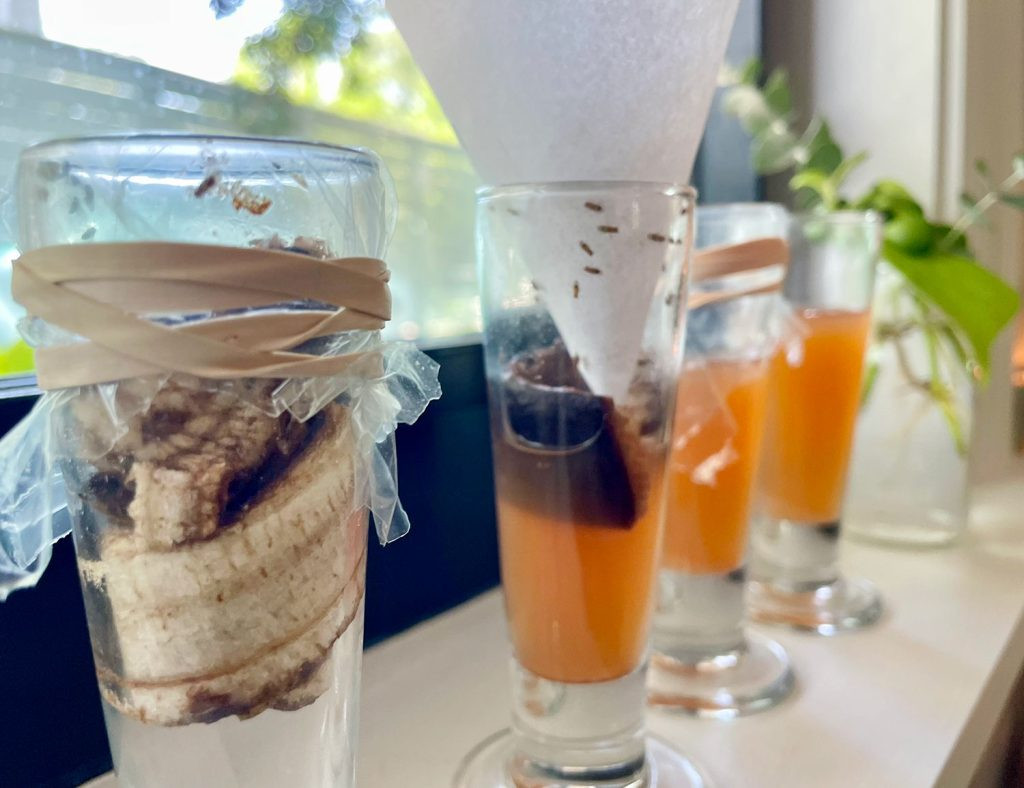 4 DIY Fruit Fly Traps Close Up
4 DIY Fruit Fly Traps Close Up
Our results indicated that the bait was more important than the trap style. Traps using banana peel performed significantly better than those with apple cider vinegar alone. The two plastic wrap traps were nearly identical in design, but the one baited with banana peel caught dramatically more flies than the ACV and soap trap. Perhaps apple cider vinegar is less appealing when real fruit is nearby?
Based on our experiment, we recommend adding a piece of fruit scrap to any trap you create! We slightly preferred the plastic wrap trap for its ease of construction and stability. We accidentally knocked over the funnel trap once, releasing some flies back into the kitchen – oops!
What Bait Attracts Fruit Flies the Most?
Driven by our success with fruit scraps, I expanded our experiment to determine the most attractive fruit bait. We tested three readily available fruits: banana peel, apple slices, and a strawberry. Each was placed in a plastic wrap trap and set out on the counter for 24 hours.
While the banana peel initially seemed promising (being the most ripe at the start), fruit flies were ultimately most attracted to the strawberry. The banana peel still caught a good number of flies, but the strawberry became increasingly effective as it ripened further. Interestingly, the apple slices didn’t catch a single fruit fly!
Store-Bought Fruit Fly Trap Options
If DIY traps aren’t working for you, or if you prefer a ready-made solution, there are effective store-bought fruit fly traps available. Many have excellent reviews and are relatively inexpensive, usually under $20. They might be a good option if you want to trap other types of flying insects or prefer a more discreet trap design.
 Collage of Storebought Fruit Fly Traps
Collage of Storebought Fruit Fly Traps
During our experiment, I purchased a pack of Terro Fruit Fly Traps to compare their performance to our homemade traps. I placed a Terro trap next to our banana and strawberry traps for 24 hours.
Again, our homemade strawberry trap performed best, followed closely by the banana peel trap. The store-bought trap caught only one fruit fly initially. HOWEVER…
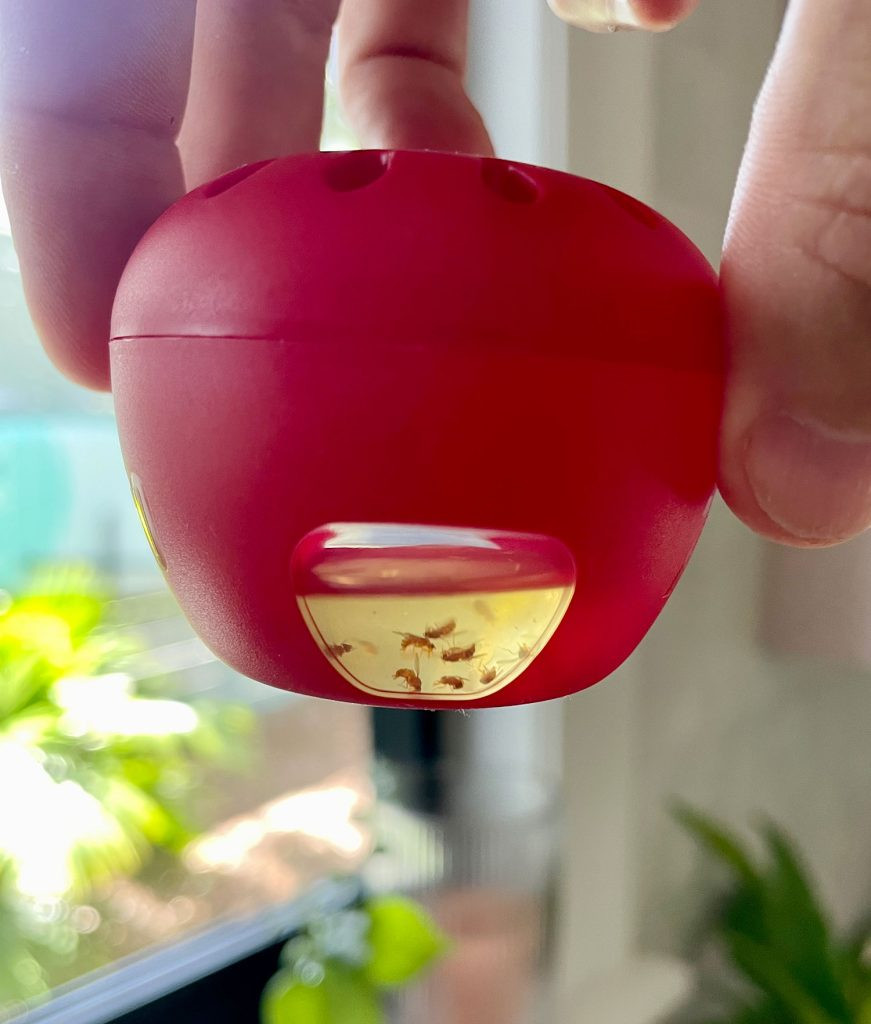 Terro Fruit Fly Trap With Dead Fruit Flies Visible
Terro Fruit Fly Trap With Dead Fruit Flies Visible
To ensure a fair comparison, we removed the DIY traps and left the store-bought trap out for another 24 hours. It then caught the impressive number of flies you see above. So, store-bought traps definitely work, but they weren’t as immediately effective as our homemade traps. Our conclusion? Store-bought traps are a good choice for discreet, longer-term control, but homemade traps are the quickest and most effective way to get rid of fruit flies right away!
Preventing Fruit Flies: Simple Steps to Take
While getting rid of fruit flies is relatively easy, preventing them from invading in the first place is even better. Here are some simple preventative measures:
- Keep Kitchen Surfaces Clean: Wipe down countertops, stovetops, tables, and any surfaces that might have food residue or spills. Fruit flies are especially attracted to fruit, sweet liquids, and alcohol, so clean up spills promptly!
- Take Out Trash Regularly: Food scraps in your garbage can become a breeding ground for fruit flies, especially if left overnight.
- Dispose of Overripe Fruit: Regularly check your fruit bowl and discard any browning or overripe fruits before they become a problem.
- Wash Produce Immediately: Washing fruits and vegetables as soon as you bring them home from the store can remove any fruit fly eggs or larvae that might be present (except for berries, which may spoil faster with washing).
- Refrigerate Produce When Possible: Fruit flies don’t thrive in cold temperatures, so storing fruits and vegetables in the refrigerator is a good preventative measure.
- Clean Sink Drains: Food particles in your sink drain can attract fruit flies. Use your garbage disposal or flush drains regularly to keep them clean.
Finally, don’t panic if you spot fruit flies! Take quick action to prevent a full-blown infestation, but remember that the solutions in this guide are easy, effective, and fast-acting. You might even enjoy becoming a fruit fly scientist for a little while, like I did!
*This post contains affiliate links, so we may earn a small commission when you make a purchase through links on our site at no additional cost to you.
